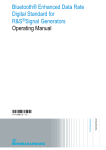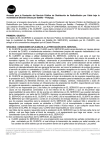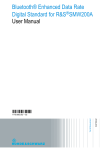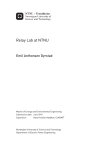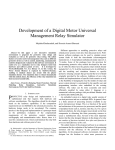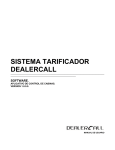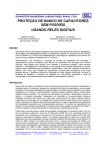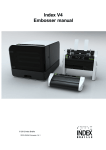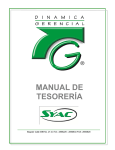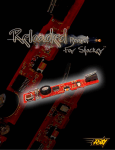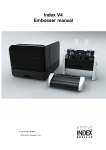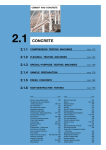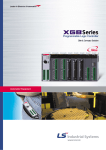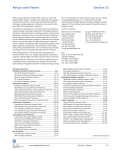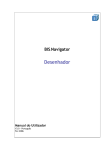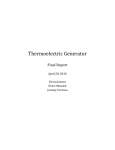Download 1 Realistic Testing of Power Swing Blocking and Out-of
Transcript
Realistic Testing of Power Swing Blocking and Out-of-Step Tripping Functions Q. Verzosa, Jr. “Jun” Doble Engineering Company Abstract Sudden changes in the power system, such as faults, network changes due to line trip outs, and disconnection of a large load or of a generating plant, forces the remaining generators to adjust and settle to new stable conditions. In some cases the swings are so large that some generators run out of step and lose synchronism. With generators having different frequencies these power swings result in voltages and currents in different parts of the networks to swing in amplitude and phase angle. The impedance measurements based on these varying voltages and currents will also oscillate. If the measured impedance becomes very small and enters the distance relay zones it can lead to an undesired trip of the distance relay. Distance relays have power swing blocking features to detect these conditions and prevent a misoperation for stable power swings. However, during the blocking period a fault can occur on the line and the distance relay must detect this condition and unblock the distance zones. For severe power swings and out-of- step conditions, it may be desirable to trip on certain transmission lines to separate parts of the system into sub-grids that will eventually settle at stable states, instead of a total system collapse, and also making it easier to restore the power system. An out-of-step tripping function can be implemented as a standalone relay or added as another function in a distance relay to detect these conditions and perform a controlled trip the transmission line. The traditional approaches for swing and out-of-step detection include parallel single or double blinders on each side of the line angle, concentric impedance elements which may be of circular shape or quadrilateral shape, with a timer to measure the impedance trajectory time from when the outer element detects the power swing until the time that the inner element detects the swing. If the time is longer than the set time the power swing blocking function will block distance elements from undesired tripping, whereas it will not block for faults. More recent methods of detecting these conditions include continuous rate-of-change of impedance, swing-center voltage, and superimposed current. Testing relays that employ these different methods of detection is a challenge. Traditional state simulation testing methods to simulate specific points in the impedance plane may work for the traditional detection schemes but will not work for the more recent power swing detection schemes. A transient playback of recorded power swings, or transient files from EMTP and stability programs provide a realistic test but require highly specialized personnel, and it is difficult to target the impedance zones to test. An easier way of simulating realistic waveforms has been developed that can test all types of power swing and out-of-step detection schemes. This paper covers the basics of power swing and out-of-step phenomena and the various schemes of detecting these conditions, and ways of testing the power swing blocking and outof-step tripping functions. 1 I. Basic Power System Stability and Power Swing Phenomena Power systems under normal system conditions are operated very close to their nominal frequency of 60 Hz or 50 Hz with very small deviations in the order of 0.02 Hz for larger systems to 0.05 Hz for much smaller systems. Under these steady-state conditions power generation and load are balanced. Fig.1. Two-Machine System Model Considering the classical two-machine system model shown in Fig. 1, the power transmitted can be represented by the equation: | |·| | | | · sin (1) Where: - is the voltage of machine S - is the voltage of machine R - is the angle by which leads = - is the rotor angle of machine S - is the rotor angle of machine R - is the total impedance between the two machines consisting of , , and - is the impedance of source S - is the impedance of source R - is the impedance of the transmission line The power angle curve shown in Fig. 2 graphically describes the power relationship between the power transmitted and the angle between the two ends. It shows that the power transfer increases with increasing angle δ from 0° to 90° and then decreases beyond 90°. Systems are normally operated well below the maximum power transfer at 90°, the maximum power transfer angle, at some power P0 corresponding to an angle δ0. The maximum power is: | |·| | (2) | | Fig. 2. The Power Angle Curve If a large disturbance occurs, such as a fault on the line, the power transmitted is suddenly reduced (the electrical output during the fault is represented by the lower curve in Fig. 3) and the electrical output of machine S decreases to PF. However, the input power P0, equivalent to the mechanical torque applied to the generator cannot instantly decrease, and this imbalance causes the machine rotor to accelerate and the angle δ increases. This analysis neglects the 2 operation of governors that change the mechanical input, and voltage regulators that control the excitation and change the machine voltage amplitudes. If the fault is cleared after some time when the angle is δc, where the electrical power is now greater than the mechanical power, the machine will start to decelerate. However, due to inertia the machine rotor angle will continue to increase to δe. At this point, Area 1, representing the accelerating energy will be equal to Area 2, representing the decelerating energy. This is referred to as the equal-area criterion in textbooks on electrical power systems. Fig. 3. The Equal-Area Criterion (Figure shows a fast fault clearance and a stable swing) If the fault is cleared quickly the Area 2 can be equal to Area 1 before the angle can reach the limiting angle δL and the system will eventually recover after some oscillation and settle at the initial operating condition at δ0, and the system is stable. The system oscillation that that occurs is considered a stable power swing. On the other hand, if the fault clearance is slow, angle δC advances too far that Area 1 becomes large enough such that Area 2 cannot become equal to Area 1 before the angle reaches δL, as shown in Fig. 4. Beyond this point the electrical power again becomes less than the mechanical power, the rotor will now accelerate again and the rotor angle will continue to increase beyond 180°. Pole slipping will occur and the machines will continue to rotate at different speeds. This Fig. 4. Unstable System due to condition is considered an unstable power Slow Clearing Time swing or an out-of-step condition. II. Relay Quantities during Power Swings Referring to Fig.1, the currents and voltages seen by a protective relay at Bus S can be calculated by the following equations: The impedance seen by a distance protective relay at bus S is calculated as: Where: 3 During power swings the frequencies of the two machines, fS and fR, become unequal and the instantaneous values of the voltages and currents have to be calculated considering the time varying rotor phase angles of both machines. The rotor angle of machines S and R at any point in time are: 2 (6) 2 (7) Where: - is the initial rotor angle of machine S - is the initial rotor angle of machine R - is the frequency of machine S - is the frequency of machine R The currents and voltages at bus S and bus R are calculated by the formulas: | | | | | | | | (8) | | | | | | | ·| | | | | | | ·| | (9) (10) The above formulas are for phase A. Power swings are generally three-phase phenomena and the phase B and Phase C quantities are 120° away from phase A. Fig. 5 shows a plot of the voltages and currents at Bus S during an unstable power swing or out-of-step condition. Fig. 5 Voltage and Current Waveforms at Bus S 4 The positive-sequence impedance seen by the relay at bus S in the direction of the line at any point is time is calculated by the equation: | | | | (11) Fig. 6 shows the plot of the impedance locus seen by a distance relay at Bus S. The trajectory of the swing locus depends on the ratio of the machine voltage amplitudes (ES/ER) and where the system electrical center is located. The electrical center is the midpoint of the total system impedance ZT. When both machine voltages amplitudes are equal the swing locus is a straight line perpendicular to ZT and passing through the electrical center, where δ=180°. A point on this line where δ=90° is also shown. When ES is larger than ER the impedance trajectory follows a large circle that passes just above the electrical center. When ES is smaller than ER the trajectory is a circle below the electrical center. When the frequency fS is larger that fR the direction of the swing is from right to left, whereas, it will move from left to right is fS is smaller than fR. Fig. 6 Impedance Trajectories Seen By a Distance Relay at Bus S Fig. 7 shows a family of circles for different ratios of |ES/ER| and different slip angles. Fig.7. Impedance Trajectories for Various Ratios of |ES/ER| 5 In a real power system the frequencies of the machines are not constant and the voltage amplitudes are dictated by other factors as well. After a system disturbance the system will have power swings mostly small swings, but some will be large enough and others may be unstable power swings. Fig. 8 illustrates some of the power swing trajectories as seen by a relay located on bus S that could occur in a power system. Two distance protection zones are also plotted. Fig. 8 Impedance Trajectories Seen By a Distance Relay at Bus S during Power Swings As shown in Fig. 8 the distance zones can see some of the power swings and can potentially operate and trip the circuit breaker. Some operations may be desired but many will be undesired tripping particularly when the swings are stable. To prevent tripping power swing blocking (PSB) schemes, also called out-of-step blocking (OSB) schemes, are used to in protection schemes to block tripping of selected distance zones . III. Power Swing Detection Schemes Following is a brief discussion of the methods that have been used for detecting power swings and schemes used for OSB and OST functions. Traditional schemes based on rate-ofchange of impedance and the newer methods that are implemented in microprocessor-based relays, are covered. A. Traditional Rate-of-change of Impedance Schemes for Detecting Power Swings Traditional methods measure the positive-sequence impedance seen by the relay and the rateof-change of impedance. During normal operating conditions the measured impedance is the load impedance and that point is far away from the distance protection zones. When a fault occurs the measured impedance jumps immediately from the load impedance to a point on the impedance plane that represents the fault. On the other hand, when a power swing occurs the measured impedance moves slowly at some trajectory in the impedance plane and at a rate depending on the slip frequency between the machines. This large difference in the speed of movement of impedance in used to differentiate between faults and power swings. This 6 method of differentiation is usually implemented using two impedance measuring elements separated by some impedance ΔZ and the use of a timer. When the measured impedance crosses one element it starts the timer. A fault is declared if the swing crosses and operates the second impedance element before the timer expires. On the other hand, if the timer expires before the impedance locus crosses the second impedance element, then the impedance movement is declared a power swing. a. Two-Blinder Scheme for PSB and OST Functions The rate-of-change of impedance method is implemented in many relays using a pair of blinders, separated by some impedance value ΔZ, and a timer tOSB. The two-blinder scheme is shown in Fig. 9. Two parallel blinders are placed to the right of the line impedance and another pair on the left side. The timer tOSB is started when the swing crosses the outer blinder. Fig. 9 Two-Blinder Power Swing Detection Scheme For a fault condition the impedance locus moves quickly to the fault impedance point and the inner blinder operates immediately well before the time expires. In case of a power swing, with a slower movement of the impedance locus, tOSB will expire before the swing locus crosses the inner blinder, in which case a power swing condition is declared. If the swing locus enters the region between the two blinders and stays there before the timer tOSB expires, a power swing condition is declared. This scheme can be used for a power swing blocking function to and block the distance relay protection zones from tripping in case the swing locus proceeds further into zone operating characteristic. A reset timer, started when the PSB asserts, is normally used to force it to deassert when the timer expires even if the impedance locus stays inside the inner blinders. Another timer may also be used delay resetting when the swing locus exits the outer blinder. The same two-blinder scheme can be used for out-of-step tripping, except that the timer tOST setting is usually shorter than when used for PSB. When a power swing occurs and the locus crosses the outer blinder the timer starts; if the timer tOST expires before the swing locus crosses the inner blinder a power swing situation is detected. If the swing continues its trajectory and crosses the inner blinder an OST condition is declared. The OST function can either be set to trip immediately or wait until the swing locus leaves the inner blinder, and after the timer tOST expires. Tripping immediately when the inner blinder is crossed is referred to as “trip on the way in” or “predictive tripping” or “early tripping”. The other case is 7 referred to as “trip on the way out” or “delayed tripping”. In some applications tripping is allowed only when pole slipping occurs after a set number of times. If the circuit breaker is not rated for out-of-phase tripping, early tripping when the slip angle is approaching 180°could damage the breaker. In this case tripping on the way out is used and an additional time may be used so that tripping will occur only when the slip angle is approaching zero degrees. If the application calls for very fast tripping before the swing develops into a full out-of-step condition where voltage is further depressed, early tripping is used but one must be certain that the circuit breaker will be capable of safely tripping on outof-phase conditions. In some applications both OSB and OST function are required. The two-blinder scheme can be use for both OSB and OST functions in the same relay. Some system disturbances produce power swings that are slower and stable while other more severe disturbances can cause unstable and out-of-step conditions with an impedance trajectory that move much faster. This difference in speed between these conditions can be used to identify if a power swing is stable or unstable. Two timers are used, one timer tOSB with a longer setting is used for identifying stable swings, and another timer tOST is used for identifying unstable swings. When the power swing impedance locus crosses the outer blinder both timers tOSB and tOST are started. If the swing locus crosses the inner blinder before both timers expire, a fault is identified, and no OSB or OST occur. If only tOST expires and not tOSB before the inner blinder is crossed an unstable power swing condition is declared and OST is asserted. If the swing is slow both timers expire before the inner blinder operates and the swing is deemed to be stable and only OSB is asserted. b. Single-Blinder Scheme of OST Function The single-blinder detection scheme is shown in Fig. 10 and can be used for detecting unstable power swing or outof- step conditions. It requires additional logic to determine the direction from where the swing entered and where it left. When a power swing impedance locus crosses one blinder from one side a timer is started. If it stays between the two blinders and the timer expires the locus later crosses the other blinder going in the opposite direction from where it entered, an outof-step condition is declared. Fig. 10 Single-Blinder Scheme Used for Out-of-step Tripping Function The single-blinder scheme cannot be used for OSB function to block a distance relay for stable power swings because the impedance locus has to cross the two blinders on both sides of the line. As in the case of the two-blinder scheme tripping can be delayed to allow the slip angle be reduced before tripping the circuit breaker. Tripping only after a certain number of pole slips can also be implemented. 8 c. Concentric Characteristic Schemes The rate-of-change of impedance method is implemented in many relays using two concentric impedance measuring characteristics separated by some impedance value, ΔZ or ΔR, or ΔX. The operation is based the same principle as the two-blinder scheme. Fig. 11 shows some of these concentric characteristics for detecting power swings and providing PSB and OST functions. The inner impedance characteristic can be an existing distance protection zone or it may be an additional impedance element specifically for the purpose of detecting power swings. The outer impedance element is usually and additional element specifically used for detecting power swings. Fig. 11 Concentric Characteristics Used in Power Swing Detection Schemes Some relays implement OST in two steps using three impedance elements - an outer characteristic, a middle characteristic, and an inner characteristic as shown in Fig. 12, and two timers. To be declared an unstable condition the power swing locus has to enter the outer characteristic to start timer 1, stay between the outer and inner characteristic until timer 1 times out, move inside the middle characteristic to start a second timer 2 and stays between the middle and inner characteristics until timer 2 expires and then enters the inner characteristic. A third timer with a very short delay may also be used which is stated by the inner characteristic and will expire as long as the swing locus stays within the inner characteristic and then will assert an OST condition. Fig. 12 Triple Concentric Characteristics for PSB and OST functions 9 A variation of this scheme is shown below in Fig. 13 using mho elements; the setting angle of each zone will affect the shape whether it will be a circles, lens or tomato. Additional blinders may be used to restrict the resistive reach of the mho elements. Fig. 13 Triple Characteristics for Power Swing Detection B. Non-Traditional Methods for Detecting Power Swings a. Continuous superimposed ΔI The superimposed current method compares the present values of currents with a buffer that is taken two cycles earlier. Figure 14 illustrates how the method works. Fig. 14 Continuous Superimposed Current Method A delta current ΔI is detected if the difference is greater than 5% of the nominal current. A continuous ΔI measurement for three cycles indicates a power swing condition and asserts PSB, provided that no distance protection element has operated. A reset delay timer maintains the block to ensure that it does not reset where the swing current passes through a natural minimum and ΔI detection might reset. Another timer can be set to limit the amount of time for blocking to allow the distance protection zones to trip. The continuous superimposed ΔI current detection method can detect very fast power swings that are hard to detect with conventional schemes especially for heavy load conditions. On the other hand, very slow slip rates below 0.1Hz, where the ΔI between two cycles is less than the threshold of 5% nominal current, are hard to detect with the ΔI method but his situation normally does not develop into swings that will enter the protection zones. 10 b. Continuous Impedance ΔZ calculation The continuous DZ calculation method monitors the trajectory of impedances to detect the power swing conditions. References [4], [7], and [9] provide a detailed description of this method. During power swing conditions the impedance trajectory generally moves in an elliptical path. The method uses an algorithm to calculate the values of R and X and compares them with previous values that are memorized. Impedances are calculated every ¼ cycle. To detect a power swing it uses several criteria for monotony, continuity and smoothness, and it uses thresholds that are calculated automatically from previous samples. Monotony ensures that the direction of movement has not changed by evaluating the derivates of R and X. Fig. 15 Monotony criterion for power swing detection Continuity ensures that the impedance trajectory is not stationary and this requires that the distance between consecutive R and X values exceed a threshold. Fig. 16 Continuity criterion for power swing detection Smoothness ensures uniform movement of the impedance trajectory with no abrupt changes, and this requires that the ratios of successive differences of R and X are below some threshold. Fig. 17 Smoothness criterion for power swing detection The algorithm dynamically adapts to the trajectory by automatically calculating the thresholds for the next calculations considering previous values. After a few (about 6) successive calculations where the stated criteria are fulfilled, a power swing condition is declared. Once a power swing is detected gradually changes such a stable swing changing direction will not result is removal of the power swing declaration unless the criteria are not fulfilled for another few successive calculations and the impedance locus is inside one of the protection zones, such as the presence of a fault. Blocking of the protection zones is started only when the swing impedance enters a starting polygon characteristic. This characteristic is automatically calculated to encompass all the protection zones to be blocked. This method of power swing detection handles slip frequencies more than 7Hz and requires no calculations for PSB applications. The dynamic calculation of thresholds allows the method to handle more complex multi-machine oscillations. 11 c. Swing-Center Voltage ( ) and Its Rate-of-Change In a two-machine equivalent system the electrical center is the electrical midpoint of the total impedance of the line and two sources. When a power swing occurs due to a slip in frequency between the two machines the voltage at the electrical center goes to zero when the angles between the two machines are 180 apart. The voltage at the electrical center of the system is referred to as the swing-center voltage (SCV). References [SEL manual, PSRC, ABB manual] provide more details of the method. Figure 18 illustrates the voltage phasor diagram of a general two-machine system, with the SCV shown as the phasor from the origin to the point o'. Fig. 18 Voltage Phasor Diagram of a Two-Machine System In a homogenous high-voltage power system the impedance angle θ is close to 90° and the diagram can be redrawn as shown in Fig. 19. Fig. 19 Vcosϕ is a Projection of Local Voltage, VS, Onto Local Current, I At the location of the relay, using the locally available voltages and currents, the voltage at the swing center can be approximated. | | · cos (12) Where |VS| is the amplitude of the locally measured voltage and ϕ is the angle difference between VS and the local current as shown in Fig. 19. For the purpose of power swing detection it is the rate-of-change of the SCV that provides the main information about the 12 power swing and the small error in the local estimate of SCV has little impact in the detection of power swings. Further approximating that the source voltages ES and ER are equal to the positive-sequence voltage E1 the positive-sequence swing-center voltage SCV1 can be simplified to: 1 1 · cos (13) The value of SCV1 is zero when the voltage angle is between the two machines is180° and maximum when the slip angle is zero. The rate-of-change of voltage at the electrical center is the time derivative of SCV1: sin (14) This equation provides the relationship between the rate-of-change of SCV and the twomachine slip frequency, dδ/dt. In Fig. 20 SCV1 and the rate-ofchange of SCV1 are plotted assuming a constant slip frequency of 1 rad/s. Note that when the angle between the two machines is zero the voltage is normal and the rate-ofchange of SCV1 is also zero; when the two machines are outof-phase with δ equal to180° the rate-of-change of SCV1 is at its maximum. Fig. 20 Plot of SCV1 and its Rate-of-change The SCV and its rate-of-change method has the following advantages: • The SCV is independent of the system source and line impedances. • The SCV is bounded with a lower limit of zero and an upper limit of one per unit, regardless of system impedance parameters. • It can detect slow swings and very fast power swings. In practice relays are usually designed for security and dependability and some minimum and maximum threshold of dSCV1 to guarantee PSB detection from 0.1Hz to 7Hz. Also to decrease the sensitivity of the power swing detector the positive-sequence impedance should be within a starter zone, which is automatically determined based on the characteristics of the protection zones to be blocked. Application of the SCV method for PSB functions requires no settings and no stability studies. The cos method is also used in out-of-step or pole-slip protection and can detect slip rates of 0.2Hz to 8Hz with additional criteria for thresholds for security. 13 d. Some Limitations The three non-conventional methods can easily detect very fast swings but may need to be complemented by conventional rate-of-change-of-impedance method for extremely slow power swings with slip frequencies of 0.1Hz or less. In general, this situation would not develop into a power swing condition that enters the distance protection zones. Under very slow power swings, conventional schemes can be set with much smaller ΔZ between the inner and outer blinders since there will be a lot of time for the impedance to travel between the two blinders. One can also set the complementary conventional inner blinder as close as possible to the distance zones to be clocked. C. Other Power Swing Detection Methods There are other power swing detection methods that have been used, are currently being investigated, or being implemented but are not covered in this paper. These include the R-Dot scheme described in reference [1], the use of Synchrophasors and wavelets. D. Some PSB and OST Application Considerations and Line Protection Requirements during Power Swing Conditions In order to properly apply PSB and OST functions detailed system studies are necessary to determine where PSB and/or OST functions are required. Reference [1] discusses these considerations and requirements in detail. The usual protection performance requirements such as speed, selectivity, reliability and sensitivity should be considered also during power swing conditions. Some general requirements are simply listed below: • During a power swing where PSB has asserted, the occurrence of a fault (balanced and unbalanced) should be detected and remove blocking in the shortest possible time to allow protection to clear the fault. • The protection should maintain selectivity when PSB is removed due to an unbalanced fault and while the slip angle between machines is close to 180° . • Protection elements should be secure to external faults during out-of-step conditions. While it may difficult for older line protection relays to satisfy these requirements, newer relays have additional logic to perform much better. These should be considered when applying PSB and OST functions and also during testing. IV. Methods of Testing PSB and OST Functions Like other protection functions, it is essential that the power swing functions are satisfactorily tested prior to placing them in service; and testing them together with the other main protection functions as a complete functional protection system is important. Testing relays that employ these different methods of power swing detection and verifying performance requirements is a challenge. 14 A. Playback Transient Data from Electromagnetic Transient Programs (EMTP) and Transient Stability Studies Transient simulation data from EMTP/ATP programs provide very realistic tests and a large number of files can be generated. Raw data from stability programs with simulation steps of a quarter-cycle or less can also be transformed into COMTRADE files for testing. However, these programs require highly specialized personnel to perform such studies and these tools are generally very expensive. It requires a large amount of time to model the power system or at least the relevant parts of the system, and a huge number of case studies for various conditions of generation and load mix, faults, relay operating times, line outages, etc. Playing back transient COMTRADE files from system studies into modern test sets is one of best ways to test the protection application and verify that the relays that will be used meet the application requirements; and such testing be performed in a laboratory. This process could be a part of selecting relays to be used for the application. For the more important line applications these studies are required and transient files are available. However, in some cases they are not readily available in the field for the test technician to use. Or, there may be so many test cases that one does not know what to use. It is also difficult to target the impedance zones and the PSB and OST characteristic boundaries to test. B. Playback disturbance records from DFRs Power system disturbances such as faults and swing recorded by digital fault recorders (DFRs) and protective relays with transient recording features can be played back to relays using modern protection test sets. These files are usually exported by the DFR and relay software in COMTRADE format. These tests provide the most realistic testing for the specific events for which they were recorded, but such recordings are limited. To test other relays with a different setting and to test for other power swing conditions there is usually not enough of these records that are applicable. C. Transient network analyzers and Real-time digital simulators Protection relays with power swing blocking and tripping functions can be tested in the laboratory with a very realistic closed-loop simulation of the power system and various system fault and switching conditions using transient network simulator and Real-Time Digital Simulators (RTDS). The RTDS can also export transient files in COMTRADE format. However, RTDS and other similar laboratory tools are extremely expensive. It also requires highly-specialized personnel to operate them and to do the modeling of various components and run various case scenarios. It is laborious and time consuming. These sophisticated power system simulation tools – EMTP and stability programs as well as RTDS – are necessary when deciding if PSB and OST functions are needed in the protection of the power system and for maintaining its stability and deciding if remedial action such as system separation is required. The application of PSB and especially OST functions need to be thoroughly studied before they are used and put in service. The settings have to be calculated, especially for the blinder-based conventional detection methods, and verified that they work for various conditions that they are intended for. In any case it is impossible to study and simulate every possible scenario as there are too many combinations and 15 permutations of generation, load, fault types, fault resistance, fault location, fault inception angles, relay and circuit breaker operating times, and network configurations. Only the most plausible scenarios are studied and simulated and these can go up to hundreds of cases. Eventually, the protective relays will have to be installed, configured, and set in the field before putting them in service. It is necessary that the relay configuration and settings are correct and verified by testing. In many cases COMTRADE files are not always available or those that are available do not verify the settings. There will also be times when testing will be required for maintenance and for trouble-shooting. The test technician in the field will not be able to rely on the power system engineer to provide transient files. Field personnel are often pressed for time to complete numerous tests of the protection system and have deadlines to finish the tests and put the relay in service. Easier and simpler ways of simulating faults and power swing conditions that are readily available to the test engineer or technician in the field are needed and these will be discussed below. D. State Simulation Test Methods Traditionally, state simulation methods of simulating impedance points, by injecting several static states of voltage and currents, have been employed for testing distance relays and power swing blocking and out-of-step tripping relays. This type of test works successfully when testing conventional power swing detection schemes that are based on stepped rate-ofchange methods using blinders and concentric characteristic that are separated by some ΔZ and fixed timers. Even this method of testing may require complex calculations, especially when one has to target impedance points at other angles away for the R axis of the impedance plane. A graphical user interface using a point-and-click with the mouse on the impedance plane, with the distance relay tripping zones and the PSB and OST characteristic drawn, makes it easy for the test technician or engineer to perform tests that target specific points. For testing a PSB function, a minimum of three points is needed, the first one in the load area for a pre-swing duration, one point between the inner and outer characteristics, and a third point inside the tripping zones. Fig. 21 Graphical User Interface for Entering State Simulation Impedance Points 16 The voltages and currents for each state are calculated based on a singlesource model with constance source impedance, providing a dynamic test values. Fig. 23 State Table of Voltages and Currents for Points Entered in Fig. 21 Fig. 22 Single-Source Model If the state duration of the second point is a little longer than the PSB timer setting it will block tripping of the tripping zone when the impedance moves to point 3; otherwise, if the state duration is less than the timer setting, PSB will not assert and the tripping zone will operate when the impedance moves to point 3. The procedure is similar when testing OST functions that employ tripping on the way in or an early trip. If the OST function is set for tripping on the way out a fourth impedance point is required and placed outside the outer zone opposite the initial load impedance. Fig. 24 Plot of Vaveforms for States showing Step Changes The main drawback of this testing method stems from the fact that it does not represent physical reality in an electrical system because of step changes or sudden jumps in the voltage and current waveforms. Real power swings are slow moving and smooth, as opposed to faults that jump instantly. Power swing detection methods that are based on continuous measurements of small delta currents or delta impedances behave unpredictably because of unrealistic test quantities. Step changes are seen by some detection methods as faults or switching conditions and not power swings. Even when using a large number of states, which is very laborious and error prone, in the hope of smoothing out the discontinuities, such tests still cannot successfully test these non-conventional power swing detection methods because measurements are made every ¼ cycle or more often. 17 E. Need for Simpler Easy to Use Testing Methods that Approximate Reality The protection test engineer or technician needs to have simpler easy-to-use tools in the field for testing PSB and OST functions, and such tools should consider the following: • • • • • • • • • Simple and easy to use by technicians with little power system background, requiring minimum input from the user. Approximate physical reality reasonably well to allow proper testing of all conventional and non-conventional methods and schemes of PSB and OST functions. It should allow complete functional testing of line protection scheme together with the PSB and/or OST functions. Visualize on an R-X diagram graphical user interface (GUI) the following: o the characteristics of the PSB and OST elements o the characteristics of the protection zones o the power swing impedance trajectory Use the GUI to aid in entering simulation points. Provide visual plot of the voltage and current waveforms. No need for additional hardware, just the existing test sets and laptops. Be able to simulate required system conditions for testing such as stable power swings, unstable power swings, load and faults Be able to target specific areas of the protection zones and the zones of the PSB and OST functions by specifying the trajectory of the power swing impedance with little effort Be able to control of source voltages, machine frequencies, and electrical center. The simulation testing methods are described below. a. Classical two-machine model The simple classical two-machine simulation model uses the same model shown in Fig.1. Fig. 25 shows the required parameters and data. Most of the data are automatically filled out based on other data that are required for testing the main distance protection functions. The main parameter that needs to be changed is the frequency of the sources to control the slip frequency. The technician can also control the trajectory of the swing locus by specifying the location of the electrical center as a percentage of the line length which can be in the range of - 100% to 300% of the line. This recalculates the source impedances in order to bring the electrical center to the desired location. Changing the source voltage amplitudes controls whether the trajectory is below or above the electrical center. The actual trajectory is displayed in an R-X diagram together with the line impedance and the relay characteristics. This allows one to control whether or not the swing locus should pass through zone selected zones of protection. The zoomed out entire swing locus is shown in Fig. 26. The relay impedance characteristics can be entered in a separate user interface used for testing the main protection functions. 18 Fig. 25 Classical Two-Machine Simulation Model Fig. 27 shows a plot of voltage and current waveforms. The points where the relay elements operated are also shown. Fig. 26 Zoom out Showing Circular Impedance Trajectory Fig. 27 Voltage and Current Waveforms Seen By Relay Timers can be set up to measure the operating time of relay trips and other elements including operation of the outer and inner power swing characteristics and when OSB asserts. Fig. 28 Timing of Various Relay Elements 19 Simulating any number of swing turns allows one to test OST functions where the relay is set to trip only after a set number of pose slips. Fig. 29 shows the waveform where the number of swing turns or pole slips is 4. Fig. 29 Simulation of Multiple Pole Slips The classical two-machine model is implemented by calculating the rotor phase angle of each machine for every step of 0.1ms, starting from the initial angles and their specified frequencies. - is the initial rotor angle of machine S - is the initial rotor angle of machine R 2 (15) 2 (16) Other quantities are then calculated in the usual way, first the current and then the voltages are each bus, using equations | | | | | | | (17) | | | | | | | | | | | | | ·| | ·| (18) | (19) The instantaneous values for the voltage and current waveforms can then be easily calculated for phase A with equations √2 · | | · sin (20) √2 · | | · sin (21) √2 · | | · sin (22) Since power swings are three-phase phenomena the quantities for phases B and C are just 120° apart and can easily be calculated with the same adjusted by -/+ 120°. 20 Because it is easy to direct where the swing locus will pass through and to specify the frequencies, it is easy to test for OST functions. The relay was tested for two different settings trip on the way in as well as trip on the way out. Fig. 30 shows the points where tripping is expected to occur. Fig. 30 Directed Power Swing Trajectory The first case for early tripping or trip on the way in resulted in tripping at 51.222 cycles from the start of the test, before the swing slip angle reaches 180° as shown in Fig. 31. Fig. 31 Trip-on-the-way-In The second case for trip on the way out resulted in tripping at 54.7 cycles from the start of the test, well after the swing leaves 180° going left, as shown in Fig. 32. Fig. 32 Trip-on-the-way-out Both cases shown above were tested for a slip frequency of 5 Hz. Additional tests down to 3Hz and up to 6Hz showed similar relays. For another test at 2Hz only PSB operated. At 7Hz OST stopped working. The classical two-machine method is very easy to use for unstable power swings. A more complete testing is also required to test for stable power swings where the swing locus does not cross the line impedance. 21 b. User-Specified Points and Smooth Rate-of-Change of Impedance Between Points This method is illustrated in Fig. 33. It involves specifying several impedance points, using mouse clicks on the R-X diagram, specifying the rate-of-change by which the impedance moves smoothly between points, and how long a point may stay stationary at a certain location to simulate a fault or load condition. For swings the rate-of-change of impedance, dz/dt, is slow and for faults the movement can be very fast or instantaneous. Fig. 33 User-specified Simulation Points for Smooth dz/dt Between Points The method calculates the voltages and currents based on a simple model with a source behind bus S where the relay is located, and the impedance of the point from the relay location as shown in Fig. 22. For ground faults the residual factor is considered. The complex impedance, ZP(t), presented to the relay varies with time and is calculated for each time step (0.1ms) of the simulation according to the specified points and rate-of-change of impedance. The current I(t) and the bus voltage VS(t) for each simulation step are calculated in the usual way. This test method allows one to test a simple scenario where an external fault occurs and is cleared and the impedance locus moves back to the load area, but then a stable power swing ensues and enters into zone 1 of the line protection and then goes back to the load area. If PSB works correctly and blocks zone1 no tripping should occur. Such a test scenario is shown in the Fig. 34. Fig. 34 Test Scenario With Fault and Power Swing 22 The table of points in Fig. 35 shows more details about each point including the speed of movement between points (dz/dt), the duration of each point as well as the source impedance (ZsMag and ZsAng) behind the relay, which can be change by the user if desired. The initial point is a load where the impedance is 36.865Ω at 9.7° for a duration of 0.5s with a source impedance of 7.8Ω at 84°. A fault (point 2) occurs in zone 2 for 0.1s and is then cleared, jumping back to the load area (point 3). After 0.05s a power swing then ensues where the swing locus moves from point 3 to point 4 at a rate of 125Ω crossing the outer and inner characteristics, which should result in PSB operation. It then moves at a slower rate of 75Ω/s to point 5, which is in zone 1, but tripping is expected to be blocked. Then it moves out of zone 1 and back to the load area through points 6 and 7. Fig. 35 Table of Simulation Test Points Fig. 36 shows the voltage and current waveforms for the above simulation points and how the relay responded. It shows the Outer characteritic operate first, then PSB asserting before the Inner characteristic could operate. Fig. 36 Plot of Waveforms and Relay Operation No tripping of the distance elements occurred when the the swing locus entered zone 1 for a few cycles. This confirmed that the relay responded correctly for this simulation scenario. 23 Another testing scenario may involve the occurrence of a power swing where the PSB function blocks zone 1, 2, and 4. While the block is asserted, a 3-phase fault occurs on middle of the protected line as shown in Fig. 37. This will test how the relay responds and how quickly it can remove the block and clear the fault. Depending on the algorithm employed by a relay, it could allow fast tripping in about 2 cycles or more or it may have to wait for the PSB duration timer to expire. In this particular case the relay PSB function asserted first. Then, when the three-phase fault on the line occurred, the PSB reset in 7 cycles and the relay tripped at the same time, as shown in the Oscillograph of Fig. 38. Fig. 37 Power Swing and Fault in Zone 1 Inside Inner Set of Blinders Fig. 38 Three-Phase Fault Inside Inner Blinder Resets PSB This particular relay tested has a feature to reset PSB faster if the impedance remained inside an additional set of inner blinders (shown in the Fig. 37 next to the line) for a certain amount of time. The timer automatically adjusts depending on how fast the power swing entered the PSB detection concentric characteristics. Simulating a faster swing locus across the two concentric characteristics makes resetting of PSB faster while simulating a slower swing results in slower resetting of PSB. Additional tests confirmed the theory of operation as described in the relay manual. Fig. 39 Power Swing and Fault in Zone1 Outside the Inner Set of Blinders Fig. 40 Oscillograph Showing PSB Assertion and Blocking of Zone 1 24 Another simulation was made as shown in Fig. 39; moving the 3-phase fault outside this inner blinder but still within zone 1, resulted in no tripping even for a longer duration of 30 cycles as shown in Fig. 40, since the PSB remained asserted. It tripped only after increasing the fault duration beyond 60 cycles. More simulation tests were carried out for unbalanced faults (such as an A-phase to ground fault and a phase-to-phase fault) outside the inner set of blinders but within zone 1; these resulted in faster tripping within 3 cycles. This simulation testing again confirmed that the negative-sequence directional element resets PSB immediately as described in the relay instruction manual. This method of simulating faults and power swings, by means of user-specified points and a specified smooth rate-of-change of impedance, makes it easier for the test engineer and technician to conduct more complex testing scenarios in the field as well as a laboratory. V. Summary and Conclusions When power systems are subjected to faults and large power system disturbances power swings both stable and out-of-step conditions can cause transmission protective relays to undesirably trip and can cause even more severe disturbances. Power swing blocking functions detect these conditions and prevent undesired operation of relays. In other severe cases of system instability separating parts of the system may be required to save it from total collapse. Out-of-step tripping functions detect unstable conditions at specific points in the power system where separation may be desired. The paper discussed the conventional and some non-conventional methods of power swing detection for PSB and OST functions. PSB and OST functions must be fully tested before putting them in service. Complete functional testing of the main protection functions together with the enable PSB and OST functions is important to verify that the relay is correctly configured and set and all elements of the protective relay interact properly In the past, the test technician had to rely on highly-specialized protection and system engineers to perform extensive transient stability studies and RTDS simulations to come up with COMTRADE files that could be used in the field to test PSB and OST protections functions. Disturbance files from DFRs and relays with fault recording capabilities also provide very realistic power system quantities for testing. However, these files or the right specific files are not always available in the field for the specific application being tested. Conventional blinder-based and concentric characteristic power swing detection schemes could be tested with conventional state simulation methods. Even state simulation methods require a highly trained test technician to calculate the test currents and voltages to successfully carry out the tests. A graphical user interface in the impedance domain allows the technician to visualize the relay characteristics and set up dynamic tests with simple mouse clicks on the R-X diagram. 25 Newer power swing detection methods and schemes, however, cannot be tested with state simulation methods because the abrupt step changes and discontinuities are contrary to physical reality and make the relays behave unpredictably. Thanks to the rapid advancement of personal computer technology and modern test sets, realistic simulation of power systems that were the domain of laboratories and mainframe computers are now possible to perform with ease in the field. The paper described two simulation methods – the classical twomachine model, and another one based on a single source where one specifies impedance points and the rate-of-change of impedance between points. The field test engineer and technician has now at his or her disposal the tools to easily and realistically simulate stable and unstable power swings and faults to perform functional testing of the protection relays together with the PSB and OST functions. The technician can use these testing methods for both non-conventional and conventional power swing detection methods and schemes. These new tools are not only for field testing but can be used in the laboratory for testing the performance of PSB and OST functions for targeted boundaries of the distance zone and power swing detection characteristics and specific slip conditions and fault combinantions. More complex situations and specific power system application of PSB and OST, however, can only be simulated using the more elaborate tools like EMTP and RTDS. COMTRADE files from these programs are can be used playback using modern test sets. VI. References [1] Power Swing and Out-of-Step Considerations on Transmission Lines. IEEE PSRC WG D6. A Report to the Power Systems Relaying Committee of the IEEE Power Engineering Society. July 2005. [2] W. A. Elmore (Editor), Protective Relaying Theory and Applications, Marcel Decker, New York. [3] GER-3180, Application of Out-of-step Blocking and Tripping Relays, by John Berdy [4] Dr. Jürgen Holbach, Siemens AG, Raleigh, NC, USA: New Out Of Step Blocking Algorithm for Detecting Fast Power Swing Frequencies, 30th Annual Western Protective Relay Conference, Washington State University, Spokane , Washington, October 21-23, 2003 [5] Demetrios Tziouvaras and Daqing Hou, "Out-of-Step Protection Fundamentals and Advancements", 30th Annual Western Protective Relay Conference, October 21-23, 2003, Spokane, Washington. [6] G. Benmouyal, D. Hou, and D. Tziouvaras, "Zero-setting Power-Swing Blocking Protection", 31st Annual Western Protective Relay Conference, October 19-21, 2004, Spokane, Washington. 26 [7] Proper detection and treatment of power swing to reduce the risk of Blackouts. J. Blumschein, Y. Yelgin, M. Kereit, Siemens AG, Energy Sector [8] MiCOMho P443/EN M/C42 Technical manual © ALSTOM 2011 www.alstom.com [9] Siemens AG, Energy Sector: User Manual Distance Protection 7SA522 V4.61, Ordering Nr. C53000-G1176-C155-5, [Online]. Available: http://www.siprotec.com [10] GEK-113248 D90Plus Instruction Manual, revision1.8x Copyright © 2010 GE Multilin 215 Anderson Avenue, Markham, Ontario Canada L6E 1B3 [11] SEL-421-4-5 Relay Instruction Manual Date Code 20101221. © 2010 by Schweitzer Engineering Laboratories, Inc. [12] 1MRK506312-UEN_A_en_Technical_reference_manual__REL670_1.2 © Copyright 2011 ABB [13] E. W. Kimbark, Power System Stability, vol. 2, John Wiley and Sons, Inc., New York, 1950 [14] C37.233-2009 IEEE Guide for Power System Protection Testing [15] F6TesT software version 2.22, Doble Engineering Company VII. Biography Quintin Verzosa, Jr. “Jun” received his BSEE degree from Mapua Institute of Technology (Manila, Philippines) in 1976. He joined National Power Corporation (Philippines) in 1978 as a relay engineer and was later promoted to principal engineer and then manager of Power System Analysis & Protection. He became manager of Protection, Control & Communications Engineering Design. In 1993 Jun joined GEC ALSTHOM in Hawthorne, New York where he worked on protection and control applications and testing; and later became Protection Systems Engineering Design manager. Jun joined Doble Engineering Company in 1998 as a senior protection engineer and is currently manager of Protection & Automation Engineering Services. He is involved in protection test systems, application support services and training, research and development of protection models and testing algorithms. He is a member of IEEE and is actively involved in several Power Systems Relaying Committee (PSRC) working groups. Jun is also involved Cigre working group WG B5.45 on testing techniques of protection and automation systems. 27



























